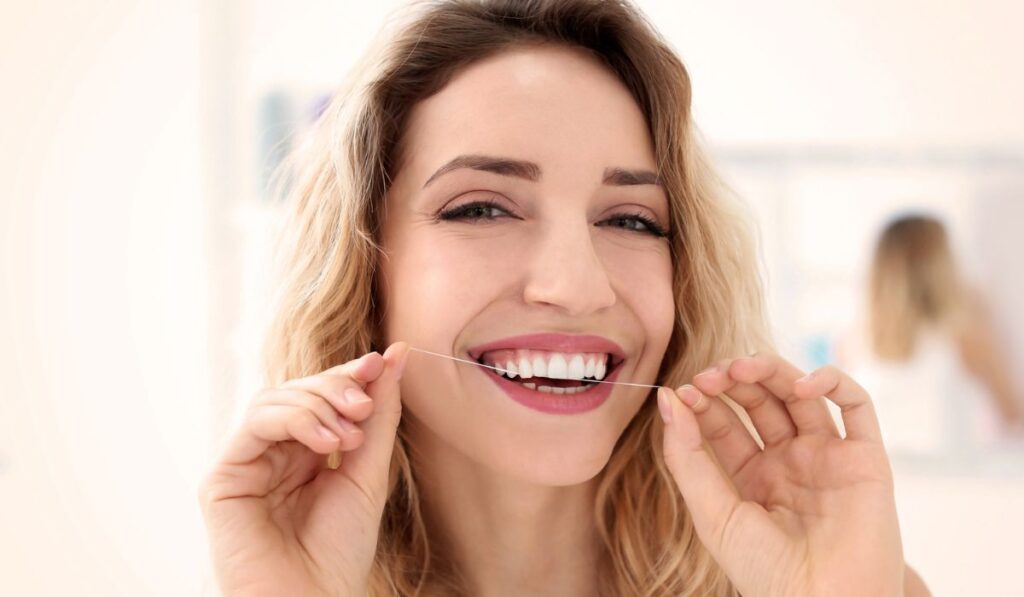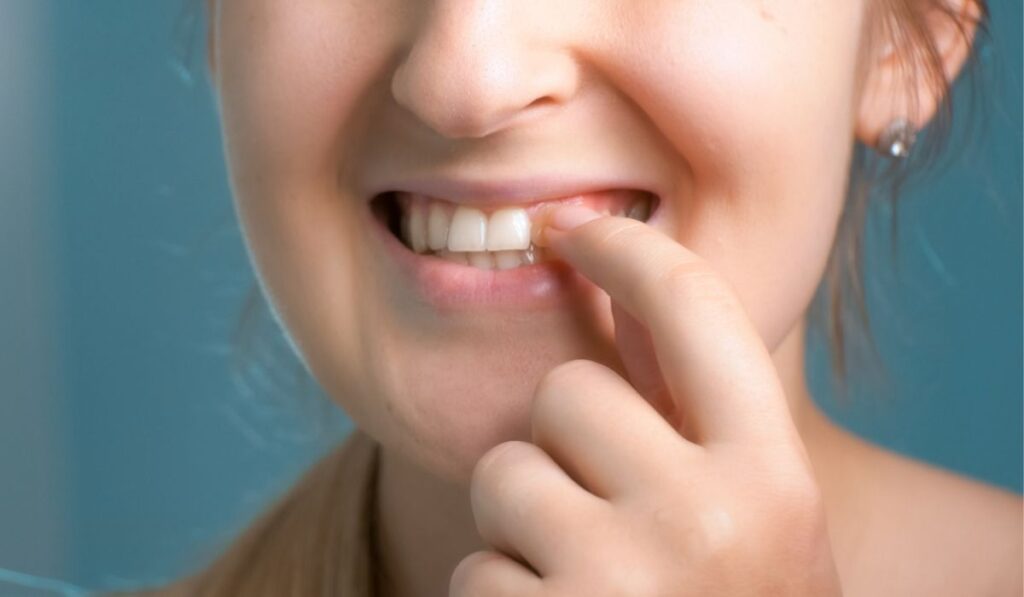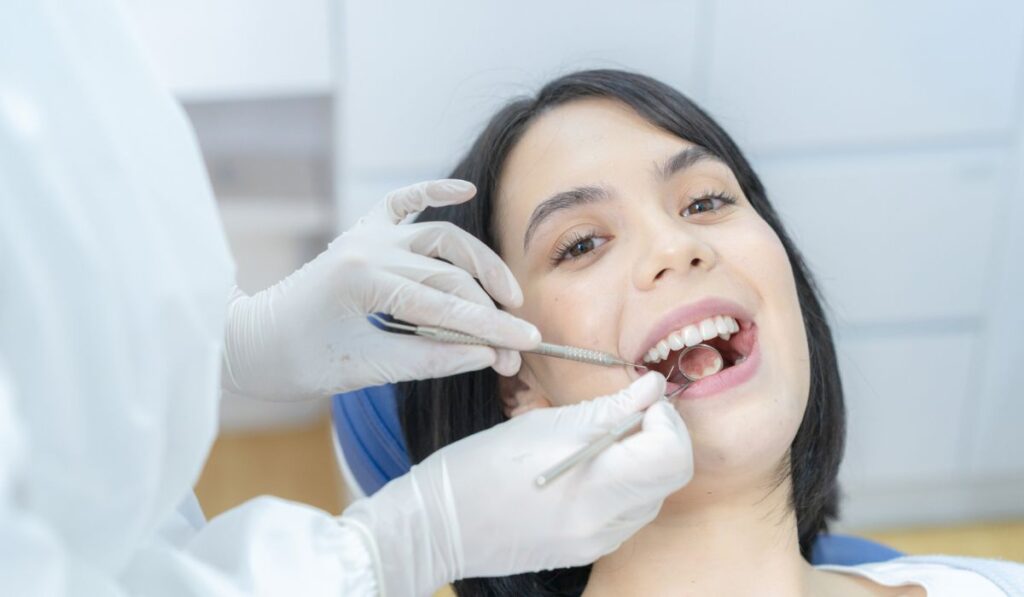We all strive for a whiter, brighter smile. Unfortunately, your teeth can become discolored over time, and many store-bought whitening products contain suspicious ingredients that raise concerns. Thankfully, there are natural ways you can whiten your smile.
To naturally whiten your teeth, you can try oil pulling, baking soda, or hydrogen peroxide. Eating a diet rich in calcium, fruits, and vegetables can also benefit the color of your teeth. However, these solutions won’t replace proper oral hygiene techniques and regular visits to the dentist.
Don’t feel discouraged if you’re seeking a whiter smile but aren’t sure what to try next. There are several techniques and preventive measures you can use to improve your teeth. Here’s everything you need to know.
Why Do Teeth Turn Yellow?

There are several reasons why teeth turn yellow and become discolored over time. One of the primary causes is poor oral hygiene and not brushing thoroughly enough. Other causes can include diet, smoking, illness, medication, and more. Let’s take a deeper look into the reasons why teeth become yellow.
Poor Oral Hygiene
Poor oral hygiene is one of the primary causes behind yellow teeth and discoloration. Teeth can start to become yellow without daily brushing, flossing, and proper care techniques. Unfortunately, even the most diligent brushers and flossers can develop discoloration over time as they age.
Diet
Diets containing certain foods and liquids can affect the color of the teeth. Foods high in tannins, including red wine and berries, can cause yellow teeth over time. Other foods that lead to discoloration include coffee and tea. The compounds in these foods can get caught in the enamel, leading to long-term discoloration.
Smoking
Smoking and using tobacco products is another leading cause of yellow, brown, and discolored teeth. The nicotine found in these products turns brown as it reaches oxygen and is absorbed into the enamel.
Smoking stains aren’t uniform and are typically around the edges of the teeth, near the gums. Thankfully, quitting these habits and practicing proper oral hygiene can help fight stains and discoloration.
Illness and Medication
Some medical conditions and medications can also cause tooth discoloration. Certain chemotherapy patients may develop stains or yellow teeth in the process.
Specific medications for asthma and high blood pressure can also cause discoloration. Be sure to consult your doctor if you’re undergoing treatment and you’re concerned about yellow or discolored teeth.
6 Natural Teeth Whitening Methods to Try!

You’re not alone if you want a whiter and brighter smile. In fact, surveys have shown that most adult Americans want a whiter smiler and spend over $1.4 billion on at-home whitening products each year.
However, these products can contain bleach, additives, and other suspicious ingredients that may not be so great for you and your teeth. Thankfully, there are several natural at-home methods you can use to potentially whiten your smile. Here are six great options for you to try.
1. Practice Proper Oral Hygiene Techniques
Practicing the best oral hygiene techniques is your first line of defense against tooth stains and discoloration. Teeth can become discolored over time as you age, but most discoloration is due to plaque buildup. Be sure to start brushing and flossing regularly if you aren’t already doing so.
Brush your teeth twice daily for at least two minutes, holding the brush at a 45˚ angle and using a circular motion. Use a soft- or extra soft-bristle toothbrush, like the Colgate 360 Extra Soft Toothbrush (on Amazon).
Make sure you’re flossing at least once a day as well. You can utilize whitening toothpaste (on Amazon) to help fight surface stains and discoloration if you aren’t opposed to the ingredients inside.
Avoid brushing right after drinking or eating acidic foods and beverages. Brushing right after consuming substances high in acidity can damage your enamel and oral health. Instead, rinse with water and wait to brush your teeth for at least 30 minutes after eating these foods.
2. Oil Pulling
For a natural remedy, you can try oil pulling, which is a traditional remedy originating from India and Ayurvedic medicine. This technique is meant to improve oral hygiene and remove harmful bacteria from the mouth.
Coconut oil (on Amazon) is a popular choice for oil pulling as it has a pleasant taste and numerous health benefits. Here are the steps for oil pulling:
- Put one tablespoon (15 ml) of coconut oil, sunflower oil, or sesame oil into your mouth.
- Swish, push, and pull the oil through your teeth for 15 to 20 minutes.
- Spit out the oil into your toilet or trash can to avoid damage to your drain pipes.
- Rinse your mouth out thoroughly with water afterward.
The idea is to remove harmful bacteria that turn into plaque, reducing your chances of yellow or discolored teeth in the process. Some studies have found that coconut oil can help reduce plaque, gingivitis, inflammation, and bacteria in the mouth.
Unfortunately, there aren’t any studies linking oil pulling to a whiter or brighter smile. However, some individuals claim to receive these results. Either way, oil pulling might be advantageous to your oral health and is worth a shot.
3. Use Baking Soda
Brushing with baking soda is another natural method for whitening teeth and improving oral hygiene. Baking soda is a natural whitener and is found in multiple commercial toothpaste brands.
The substance is a natural abrasive that can help remove surface stains as well as help kill bacteria. Here are the steps for creating a baking soda remedy:
- Mix 1 teaspoon (6 grams) of baking soda with two teaspoons of tap water (5 ml) to create a paste.
- Brush the teeth using the paste for two minutes in a circular motion using a soft-bristle toothbrush.
- Spit out the solution and rinse thoroughly with water afterward.
You can use this technique a few times per week during your routine.
You can also opt for toothpaste brands containing baking soda, like Arm & Hammer (on Amazon). In fact, some studies have shown that these toothpaste brands were significantly more effective at reducing plaque, gum inflammation, and bleeding.
Keep in mind that you might not notice results immediately. However, you should notice a gradual difference in your smile and oral health over time.
4. Use Hydrogen Peroxide
Brushing or swishing with hydrogen peroxide is another home remedy you can use to potentially whiten your smile. Hydrogen peroxide is a natural bleaching agent that kills oral bacteria and has been used for years.
In fact, many commercial whitening products use high concentrations of hydrogen peroxide. Here are the options for using hydrogen peroxide for your smile:
- You can use hydrogen peroxide as a mouthwash before you brush your teeth. Ensure you’re using 1.5% or 3% solutions to avoid harmful effects. You can dilute 3% solutions to 1.5% using equal parts peroxide and water.
- You can also use hydrogen peroxide in toothpaste by mixing it with the baking soda solution above. Combine two teaspoons (10 ml) of hydrogen peroxide with one teaspoon (6 grams) of baking soda and brush your teeth using the mixture. Be sure you’re using 1.5% or 3% hydrogen peroxide, and only use this remedy a few times per week.
Some studies have linked hydrogen peroxide to more effective whitening and removal of surface stains.
Like the baking soda solution, you might not notice immediate benefits, and the effects will be over time. Be sure to limit your use to a few times per week, as overuse can lead to harmful side effects and erode your enamel over time.
5. Eat Fruits and Vegetables
Fruits and vegetables benefit your overall health, including your teeth. Fruits and vegetables aren’t a substitute for daily brushing. However, crunchy, raw fruits and vegetables can help rub plaque away as you chew. Two of the primary options include strawberries and pineapples.
Strawberries
Natural strawberry and baking soda solutions are common remedies recommended by celebrities and other proponents. The idea is that the malic acid found in strawberries will fight discoloration, while the baking soda works to fight stains. Here are the steps for adding strawberries to your routine:
- Mash a fresh strawberry and combine it with the baking soda solution above.
- Brush your teeth with the paste for two minutes in a circular motion using a soft-bristle toothbrush.
- Spit out the solution and rinse thoroughly with water afterward.
Unfortunately, this natural solution isn’t backed by science. Although strawberries can help exfoliate your teeth, they’re unlikely to reach deep stains in your teeth. Be sure to only use this technique a few times per week, as excessive use can cause damage if you aren’t careful.
Pineapples
Proponents of the fruit method also suggest using or eating pineapples to improve your smile. Pineapples contain an enzyme known as bromelain. One study found that gels made with this enzyme could help remove tooth stains. Unfortunately, there isn’t any evidence that eating pineapples create the same effects.
You can mash fresh pineapple with the baking soda solution listed above to try and achieve the same results. Be sure to limit this method to a few times per week to avoid unnecessary damage.
6. Use Banana, Orange, or Lemon Peels
Using the peels from bananas, oranges, or lemons is another way you can use fruits to potentially enhance your smile. Proponents of this natural remedy claim that they achieved a whiter and brighter smile. Here’s how to use fruit peels to your advantage:
- Rub the peel of a banana, orange, or lemon on your teeth for up to two minutes.
- Thoroughly rinse your mouth out with normal water afterward.
It’s best to limit this remedy to a few times per week and wait 30 minutes before or after brushing your teeth.
Keep in mind that this method isn’t backed by science and could be harmful in some cases. The idea is that citric acid will help whiten your teeth. However, overuse could lead to sensitivity and damage to your enamel.
For those reasons, it’s best to limit this remedy to a few times per week. Be sure to stop using this technique immediately and consult your dentist if you’re experiencing any sensitivity, pain, or discomfort.
How to Prevent Yellow Teeth in the First Place
Unfortunately, teeth naturally become yellow and discolored over time as you age. Thankfully, there are some steps you can take to prevent stains and yellow teeth before they happen.
Avoid Foods and Beverages That Stain
Certain foods are known for staining teeth. Coffee, red wine, soda, and dark berries can negatively impact the color of your smile over time. However, you don’t have to cut these foods and beverages out of your diet entirely.
Be sure to avoid and limit the amount of exposure these substances have to your teeth. After consuming them, rinse with water immediately, and wait to brush your teeth for at least 30 minutes.
You can also use a straw for certain beverages to avoid the amount of contact and exposure they have on your teeth. Use a straw for coffee, red wine, soda, and alcohol to avoid unnecessary damage and discoloration.
Limit Sugar
Limiting your sugar intake is another way you can prevent stains and discoloration on your teeth. Diets high in sugar promote the growth of harmful bacteria that causes plaque and gingivitis. This bacteria can lead to harmful consequences if not treated properly.
After consuming sugary foods, be sure to rinse with water right after or brush your teeth after 30 minutes to avoid unnecessary damage and discoloration. Brushing too soon after consuming sugary foods can damage your enamel. You can also swish water after eating sugary foods to help remove the harmful bacteria.
Get Enough Calcium
Tooth stains and discoloration can be caused by enamel erosion that exposes the yellow dentin underneath the surface of your teeth. Eating foods and beverages that strengthen your enamel can help keep your smile in good condition.
Try adding calcium-rich foods to your diet, such as cheese, milk, or broccoli, to prevent enamel erosion and strengthen your teeth.
Avoid Smoking and Other Tobacco Products
Reducing or stopping your use of certain products can improve your smile if you’re a smoker or use tobacco. Cigarettes, vapes, and other tobacco products can lead to stains and discoloration over time.
You can consult your doctor or dentist to determine what steps you can take to quit or reduce your use of certain products. They might have you wean off or use nicotine replacement products such as patches, lozenges, or gum.
Consult Your Dentist

Natural remedies and solutions might help your smile in the short term or over time. However, these techniques aren’t a replacement for proper oral hygiene or regular visits to the dentist. Be sure to practice proper oral hygiene techniques by brushing and flossing twice a day.
Ensure you’re regularly consulting your dentist for a checkup and cleaning. The dentist will give your teeth a deep cleaning, removing any plaque, tartar, or bacteria in the process. Your dentist will also determine if you have symptoms of gum disease and prepare a treatment plan if necessary.


